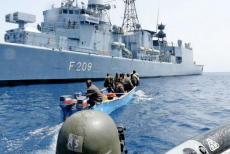
To most people the word ‘pirate’ probably conjures images of peg legs, eye patches and parrots perched on shoulders. The popular movie franchise Pirates of the Caribbean has done much to paint the life of an eighteenth century pirate as one of swashbuckling adventure, with pirates as the loveable anti-heroes against the oppressive British crown. It seems incongruous, or out of place, therefore to see the word appear in modern news—but pirates did indeed present international governments with trouble in the twenty-first century.
The story of modern piracy begins in early 1980s Somalia. The government had launched a program to develop the nation’s fishing industry, which included foreign investments. No large-scale fishing had taken place off Somalia’s coast, so it was seen as a site of significant potential development. Foreign fishing was permitted but only with an official license. However, this program had barely begun before civil war broke out in 1986; by 1991 the government under President Siad Barre had been overthrown. With the government went the fishing development program, as well as the Somali Navy, leaving the country’s waters undefended. Soon foreign, mostly Asian and European, companies began to illegally fish there, with no licensing system in place to cap the amounts they were taking. By some estimates these companies were stealing up to $300 million worth of fish every year. To make matters worse, some companies even used the unprotected space to dump waste, leading to even further erosion of the fish stocks. These actions might have helped to fuel the civil war, as the foreign fishermen took to paying off corrupt local officials to protect their actions, causing further instability in the country.
In response to this local fishermen banded together to protect their resources, forming armed groups to take on the huge trawlers. Soon they turned to hijacking the vessels, as the ransoms they could demand provided an alternative source of income in the face of depleted fishing. Modern Somali piracy was born. These origins were reflected in the names of some of the piracy networks, for instance the ‘National Volunteer Coast Guard.’ In 2008 one such group captured the Ukrainian-owned MV Faina. They demanded $3.2 million of ransom money for the crew of twenty-one, and announced that this money would be used to clean the waste from Somali’s shorelines.
Seeing the profitability of ransom payments some financiers and former militia began to fund pirate activities, splitting the profits with the pirates. This allowed the groups to grow, and from late 2008 they began to target larger ships including huge international cargo ships, oil and chemical tankers. In 2008 there were 111 attacks, which lead to 42 successful hijackings, and altogether some $90 million of ransom money was paid to various piracy groups. This had a positive effect on the lives of Somali people, with small towns rejuvenated by the pirate’s spending, while the fish stocks improved due to decreased commercial-scale fishing. As well as local support, the pirates even received funds, equipment and information from Somalis abroad. However, the actions of the pirates were still unlawful, and could be violent. Kidnapped sailors held for ransom could be injured or killed, and could be kept as hostages for years at a time. Two Thai fishermen were held hostage for five years. To this day, 26 hostages are still being held from the Oman-flagged FV Naham 3, captured in March 2012.
Since 2006 the international Combined Task Force 150 began conducting anti-piracy operations off the coast of Somalia, and in 2008 established a Marine Security Patrol Area around the Gulf of Aden to protect the ships using the area for trade. In 2009 Combined Task Force 151 was established specifically to counter piracy and was not geographically constrained, which meant it could chase pirates even into Somali territory. NATO founded Operation Ocean Shield in 2009 specifically to protect its World Food Programme ships which transport relief supplies to the region. Alongside these defensive measures there was also an international recognition that more security in the country would lead to less piracy in the seas. As the UN Secretary General Ban Ki-moon told delegates at a conference, “piracy is a symptom of anarchy and insecurity on the ground.” In April 2009 international donors pledged $250 million for Somalia, including $134 million to increase the African Union peacekeeping mission from 4,350 troops to 8000, and $34 million for Somalia’s own security forces. Crucially there was also an enforced recognition of Somalia’s Exclusive Economic Zone, putting an end to the illegal fishing. These anti-piracy efforts have been largely successful, with pirate attacks falling steadily since 2010, and finally dwindling to a mere handful by 2013.
Image: http://worldmaritimenews.com/wp-content/uploads/2015/01/Falling-Piracy-Figures-Hide-Worrying-Trends.jpg

0 Comment:
Be the first one to comment on this article.